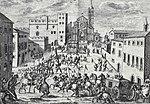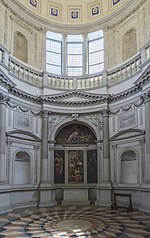The Abbey of San Zeno was erected in the 9th century on the remains of a preexisting monastery, whose origins date back to the 4th century. Of the abbey, the abbey tower of San Zeno and several cloisters that are now part of the Basilica of San Zeno survive. It was very important both for the history of Verona and for the relations the German emperors had with Italy.
Historians have ascertained the presence of an early Christian sacellum from the 4th century in the cloisters, now called the sacellum of St. Benedict, however, the construction of the abbey proper was given impetus in the 9th century in the Carolingian era and developed at the behest of the Veronese archdeacon Pacifico, Bishop Rotaldo and the Frankish king Pepin, son of Charlemagne. According to images from the period and recent findings, there was a second tower located to the northeast and the Abbot's palace, adjacent to the abbey tower. Before the extension of the city walls by the Scaligeris, the area of San Zeno was outside the walls and therefore the buildings in the ward were often located so as to be safe and to obtain defense even though they were located outside the city: in that historical phase the ward was thus developed, protected precisely by the presence of the abbey itself.
It was destroyed in the Napoleonic era and therefore did not follow the fate of Verona's abbey properties, which upon the replacement of the French by the Austrians became part of the Austrian state property, sometimes redeemed as in the case of Santa Maria in Organo. From the beginning of the nineteenth century began a period of divestment of the ancient Benedictine abbey that ended in the mid-twentieth century. From the post-war period onward, numerous restoration works were carried out on the tower and part of the original abbey, which can currently be visited and are well maintained.











